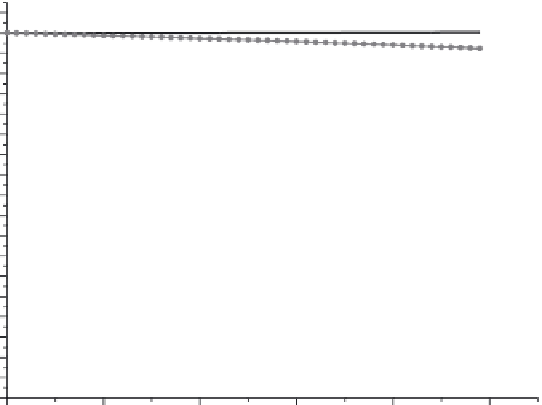Biomedical Engineering Reference
In-Depth Information
0.01
0.00
-0.01
-0.02
-0.03
-0.04
-0.05
-0.06
-0.07
e
-0.08
-0.09
-0.10
-0.11
-0.12
(
p
= 2 MPa)
(
p
= 4 MPa)
(
p
= 6 MPa)
(
p
= 8 MPa)
-0.13
-0.14
-0.15
-0.16
-0.17
-0.18
0.0
0.5
1.0
1.5
2.0
2.5
t
(10
6
second)
FIGURE 3.3
Variation of
e
with time
t
(φ
b
− φ
a
=
T
0
=0 and
P
= 1500 N).
which the porosity of the femur will be reduced. The critical
value
p
r
0
in this problem is approximately 2.95 MPa. It is also
evident that the porosity of the femur increases along with the
increase of external pressure
p.
• Case 2:
P
= 1500 N and internal pressure is produced by inserting a
rigid pin whose radius
a
*
is greater than
a
• The values of
e
as a function of
t
for
a
*
-
a
= 0.01, 0.03, and 0.05 mm
are shown in Figure 3.4. It is interesting to note that for the three
cases, the bone structure at the pin-bone interface adapts itself
initially to become less porous and then to a state with even less
porosity. This is followed by a quick recovery of porosity, indi-
cated by a sharply decreased value of
e.
As time approaches infin-
ity, the bone structure stabilizes itself at a moderately reduced
porosity. Although dramatic change of the remodeling constant
is observed during the remodeling process, it is believed that the
effect of the change on bone structures is limited by the fact that
the duration of the change is very short compared to the entire
remodeling process. This result coincides with Cowin and Van
Buskirk's [4] theoretical observation, which showed that a bone
structure might tend to a physiologically impossible bone struc-
ture in finite time. Both these conditions have been observed
clinically and classified as osteoporosis (excess density with the













